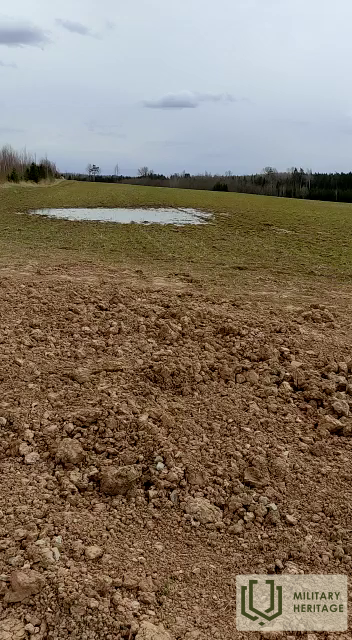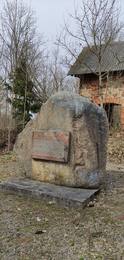Kämpfe auf Gut Kaulači im März 1945
1945 gab es in der Nähe des Halbguts Kaulači einen Beobachtungsposten der Roten Armee. Augenzeugen berichteten, dass im März 1945 Kämpfe ausbrachen. Es ist nicht das erste Mal, dass auf diesem Feld Gräber aus der Zeit des Zweiten Weltkriegs gefunden wurden.
In der Gemeinde Remte, im Bezirk Brocēni, in der Nähe der Häuser von „Kaulači“, wurden 2021 die sterblichen Überreste von 23 deutschen Soldaten exhumiert. Einst stand dort ein Herrenhaus gleichen Namens, und 1945 befand sich dort ein Beobachtungsposten der Roten Armee.
Augenzeugen berichteten, dass die Kämpfe im März 1945 begannen. Minen fielen, Maschinengewehre ratterten, Kanonen donnerten, und Zivilisten gerieten bei Pilsblīdene zwischen zwei Frontlinien. Nach den Kämpfen brannten die acht nächstgelegenen Häuser, darunter das Gut „Kaulači“, ringsum wie große Feuer.
Nach dem Krieg blieben tote deutsche Soldaten und lettische Legionäre auf dem Schlachtfeld zurück. Die Rote Armee barg ihre Gefallenen. Jeder Hausbesitzer bestattete die Toten so gut er konnte, denn die Sowjetregierung hatte angeordnet, dass die Gefallenen begraben werden mussten. Andernfalls würden in der Gegend verschiedene Krankheiten ausbrechen.
Es ist nicht das erste Mal, dass in diesem Feld Gräber aus dem Zweiten Weltkrieg gefunden wurden. Bei den Ausgrabungen entdeckte man, dass vier Gewehre, ein Helm und ein Kesseldeckel mit teilweise lesbaren Initialen ebenfalls in den Schützengraben geworfen worden waren. Außerdem wurden mehrere deutsche Münzen, ein Bündel Gasmasken und einige Kleidungsstücke freigelegt.
https://skaties.lv/zinas/latvija/sabiedriba/remtes-pagasta-atrod-bez-vests-pazudusus-karavirus/
Zugehörige Zeitleiste
Zugehörige Themen
Zugehörige Objekte
Denkmal für das 8. Estnische Schützenkorps der Roten Armee
Das Denkmal für die Soldaten des 8. Estnischen Schützenkorps der Roten Armee befindet sich bei den Ruinen des Halbguts Kaulači etwa 100 Meter südwestlich der Straße.
Am 17. März 1945 begann der letzte Offensivversuch der Roten Armee in Kurland. Die 7. estnische Schützendivision des 8. estnischen Schützenkorps hatte die Aufgabe, die Eisenbahnlinie Riga-Liepaja westlich des Bahnhofs Blidene zu erreichen und den Angriff des 3. mechanisierten Gardekorps in Richtung Gaiki zu sichern. Am Abend des 17. März erreichte das 354. Schützenregiment durch den Wald die Eisenbahnlinie südlich des Halbguts Kaulači und setzte seine Angriffe in nordwestlicher Richtung fort, bis es die Häuser von Pikuliai erreichte. Im Halbgut Kaulači und weiter nordöstlich befanden sich die deutschen Burg-Stellungen, die von einzelnen Einheiten der 329. Infanterie-Division verteidigt wurden. Den ganzen Tag des 18. März wurden die Angriffe des 354. Schützenregiments erfolglos fortgesetzt.
Am Abend des 18. März wird das 354. Schützenregiment durch das 27. Die Vorhut der 7. mechanisierten Brigade des 3. mechanisierten Gardekorps, das 1. motorisierte Bataillon mit einer Panzerkompanie, sollte ebenfalls für den Angriff eingesetzt werden. Am Abend des 19. März eroberten die Sowjets in einem konzentrierten Angriff das Halbmausoleum Kaulauchi und nahmen einen Teil der von den Deutschen errichteten Verteidigungslinie auf der dominierenden Anhöhe ein.
Bis Ende März 1945 wurden die Angriffe des 8. estnischen Schützenkorps und des 3. mechanisierten Korps in Richtung Wikstraute und Remte fortgesetzt, jedoch ohne Erfolg.
Während der Kämpfe beherbergte das Halbschloss Kaulači verschiedene Ebenen von Hauptquartieren, und im Mai 1975 wurde an dieser Stelle ein Gedenkstein enthüllt.






